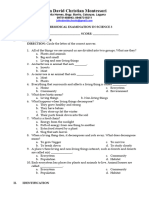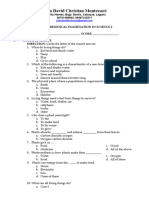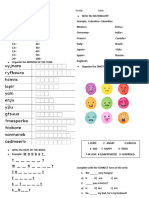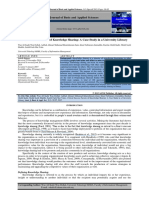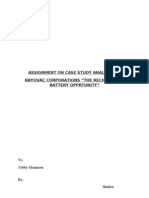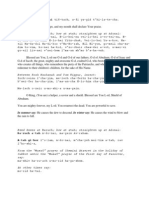0 ratings0% found this document useful (0 votes)
36 viewsHE G6 Term 1 Test
HE G6 Term 1 Test
Uploaded by
AnneThis document contains a Home Ecology Grade 6 term 1 test with questions testing knowledge of families, environments, nutrition, and healthy living guidelines. The test includes multiple choice questions about the definition of family, components of the near environment, interactions with the near environment, nutrients like starch and calcium, and the function of fiber. It also includes fill-in-the-blank and matching questions about developing life skills to help oneself and others, practical crafts, nutrients, and food and nutrition guidelines including eating a variety of food and drinking clean water.
Copyright:
© All Rights Reserved
Available Formats
Download as PDF, TXT or read online from Scribd
HE G6 Term 1 Test
HE G6 Term 1 Test
Uploaded by
Anne0 ratings0% found this document useful (0 votes)
36 views2 pagesThis document contains a Home Ecology Grade 6 term 1 test with questions testing knowledge of families, environments, nutrition, and healthy living guidelines. The test includes multiple choice questions about the definition of family, components of the near environment, interactions with the near environment, nutrients like starch and calcium, and the function of fiber. It also includes fill-in-the-blank and matching questions about developing life skills to help oneself and others, practical crafts, nutrients, and food and nutrition guidelines including eating a variety of food and drinking clean water.
Original Description:
HE test
Original Title
HE G6 Term 1 test
Copyright
© © All Rights Reserved
Available Formats
PDF, TXT or read online from Scribd
Share this document
Did you find this document useful?
Is this content inappropriate?
This document contains a Home Ecology Grade 6 term 1 test with questions testing knowledge of families, environments, nutrition, and healthy living guidelines. The test includes multiple choice questions about the definition of family, components of the near environment, interactions with the near environment, nutrients like starch and calcium, and the function of fiber. It also includes fill-in-the-blank and matching questions about developing life skills to help oneself and others, practical crafts, nutrients, and food and nutrition guidelines including eating a variety of food and drinking clean water.
Copyright:
© All Rights Reserved
Available Formats
Download as PDF, TXT or read online from Scribd
Download as pdf or txt
0 ratings0% found this document useful (0 votes)
36 views2 pagesHE G6 Term 1 Test
HE G6 Term 1 Test
Uploaded by
AnneThis document contains a Home Ecology Grade 6 term 1 test with questions testing knowledge of families, environments, nutrition, and healthy living guidelines. The test includes multiple choice questions about the definition of family, components of the near environment, interactions with the near environment, nutrients like starch and calcium, and the function of fiber. It also includes fill-in-the-blank and matching questions about developing life skills to help oneself and others, practical crafts, nutrients, and food and nutrition guidelines including eating a variety of food and drinking clean water.
Copyright:
© All Rights Reserved
Available Formats
Download as PDF, TXT or read online from Scribd
Download as pdf or txt
You are on page 1of 2
Home Ecology Grade 6: Term 1 Test
Name: Date:
1. Choose the correct answer. Write the correct letter only.
a) Which statement defines the term family?
A. Family is the people that live with you and care for you.
B. Family is only your parents.
C. Family can be your friends at school.
D. Family is all your relatives even those that live far away.
b) Your near environment includes …
A. the global community, which means everyone in the whole world.
B. the people that you come into contact with directly at school and
in the town or village.
C. only your relatives.
D. people in your town or village that you don’t know.
c) You interact with your near environment when you …
A. play a ball game with your neighbours.
B. write a letter to a friend who lives in another town.
C. make supper for your family.
D. bath your baby sister.
d) Which nutrient forms part of carbohydrates?
A. vitamin C
B. animal fat
C. starch
D. calcium
e) The function of fibre in the body is to …
A. provide energy.
B. grow new cells.
C. build bones.
D. prevent constipation.
f) Calcium is found in …
A. butter.
B. milk.
C. oranges.
D. maize. (6)
Home Ecology Grade 6 Permission is granted to photocopy this page
2. Copy and complete the sentences by filling in the missing words.
a) In Home Ecology you learn things that will help to ______ your own
life and the lives of your ______.
b) You will develop practical living ______ that will help to improve the
______ of your family life and of your near environment.
c) You will learn about the Namibian way of life and how to become a
valuable ______ of your community. (5)
3. Name TWO of the practical crafts that you can learn to do in Grade 6. (2)
4. Name the five nutrients. (5)
5. a) Match each space in Column A with a word from Column B. Write
down only the matching numbers and letters, for example 1 K. (10)
Column A Column B
Food and Nutrition Guidelines Words
1. Eat a _____ of food. A. salt
2. Eat vegetables and _____ every day. B. three
3. Eat more _____. C. alcohol
4. Eat _____ or meat regularly. D. weight
5. Use _____ products. E. water
6. Use only iodised _____, but use less salt. F. beans
7. Eat at least _____ meals a day. G. fruit
8. Avoid drinking _____. H. wholegrain
9. Consume clean and safe _____ and food. I. variety
10. Achieve and maintain a healthy body _____. J. fish
b) Two of the ten guidelines refer to lifestyle issues. Name them. (2)
Total [30]
Home Ecology Grade 6 Permission is granted to photocopy this page
You might also like
- End of Third Term Examination 2020/2021 Academic Session Instructions: Answer All Questions Example: AnswerDocument23 pagesEnd of Third Term Examination 2020/2021 Academic Session Instructions: Answer All Questions Example: AnswerMarkus Thomas86% (7)
- PENI Soal B.Inggris kelas 10 - OKEDocument3 pagesPENI Soal B.Inggris kelas 10 - OKEsu yitnoNo ratings yet
- Basic 1 Second Term ExamDocument11 pagesBasic 1 Second Term ExamErhenede FejiriNo ratings yet
- (Ub - Net) de TA Thi Cong Chuc So 2 - de Bai THUE 2018Document7 pages(Ub - Net) de TA Thi Cong Chuc So 2 - de Bai THUE 2018duyenth399No ratings yet
- SUBJECT - SCIENC-WPS OfficeDocument9 pagesSUBJECT - SCIENC-WPS Officegodspowerakpan079No ratings yet
- Go, Send, Teach, Become, Not Make, Study, Invade, Decide, Design, SpendDocument6 pagesGo, Send, Teach, Become, Not Make, Study, Invade, Decide, Design, SpendThảo NguyênNo ratings yet
- ANH HK1Document8 pagesANH HK1Minh ngọc BùiNo ratings yet
- Test Version 1 (Quarter I)Document9 pagesTest Version 1 (Quarter I)Dilshod KazakovNo ratings yet
- P3 Science Final Test Semester 1Document6 pagesP3 Science Final Test Semester 1Sun WilsNo ratings yet
- UNIT 1.test.2023Document6 pagesUNIT 1.test.2023baongoc31032008No ratings yet
- REVISION WORKSHEET - Half Yearly - SCIENCE - CLASS 4Document3 pagesREVISION WORKSHEET - Half Yearly - SCIENCE - CLASS 4hadakanishka09No ratings yet
- Giua Ki 1Document4 pagesGiua Ki 1Ninh GiangNo ratings yet
- Unit 1,2 Time 45 MinutesDocument8 pagesUnit 1,2 Time 45 MinutesPhan Thị Ngọc HânNo ratings yet
- Anh 8 ngoài (25 bản) có bìa trắngDocument66 pagesAnh 8 ngoài (25 bản) có bìa trắngLinh Phuong LeNo ratings yet
- Third Periodical Examination in Science 3Document2 pagesThird Periodical Examination in Science 3Jan Ira RenolayanNo ratings yet
- exercise-2-hk-1-lop-7-676131c2e2cc8zbw07Document2 pagesexercise-2-hk-1-lop-7-676131c2e2cc8zbw07dungnguyen.trandatNo ratings yet
- Long Test in BiochemistryDocument2 pagesLong Test in BiochemistryLymberth BenallaNo ratings yet
- Review For The Mid-Term Test English 10Document9 pagesReview For The Mid-Term Test English 10Khánh Nguyễn Phạm NgọcNo ratings yet
- Answers and Audio ScriptDocument3 pagesAnswers and Audio Scripttuongvi leNo ratings yet
- REVIEW FOR THE 1ST SEMESTER EXAMDocument9 pagesREVIEW FOR THE 1ST SEMESTER EXAMnhuy365081No ratings yet
- 10 English Lang SP 02 PDFDocument11 pages10 English Lang SP 02 PDFChhabi BhatnagarNo ratings yet
- Third Periodical Examination in Science 2Document3 pagesThird Periodical Examination in Science 2Jan Ira RenolayanNo ratings yet
- 10 English Lang SP 02Document11 pages10 English Lang SP 02naveen_halkNo ratings yet
- BT điền từ - KeyDocument4 pagesBT điền từ - KeyLam Thúy100% (1)
- Score A+Document21 pagesScore A+ainsaadahNo ratings yet
- RO9_semester 1 92A, 92BDocument5 pagesRO9_semester 1 92A, 92BphucthomcsNo ratings yet
- Revision For The Mid Term Test E7Document7 pagesRevision For The Mid Term Test E7Bich HuongNo ratings yet
- Question-1479953 Grade 10Document4 pagesQuestion-1479953 Grade 10K RajaNo ratings yet
- EVS WS-grade II FinalDocument4 pagesEVS WS-grade II FinaljackhpatelNo ratings yet
- SCIENCEDocument5 pagesSCIENCEjessatinagan.vaNo ratings yet
- Unit 2Document7 pagesUnit 2Ngô Lan PhươngNo ratings yet
- A1 Full DiagnosticDocument3 pagesA1 Full Diagnosticarey27575No ratings yet
- Reading BDocument11 pagesReading BYukari SatoNo ratings yet
- 2nd Quarter-SummativeDocument7 pages2nd Quarter-Summativeenokarla590No ratings yet
- English 2024Document34 pagesEnglish 2024Abdus Shahid Al MasrufNo ratings yet
- ĐỀ CƯƠNG ÔN GIỮA KÌ 1 LỚP 11. 2024-2025-1729650891Document17 pagesĐỀ CƯƠNG ÔN GIỮA KÌ 1 LỚP 11. 2024-2025-1729650891Thu Nguyen AnhNo ratings yet
- Nisha 30 AugDocument77 pagesNisha 30 AugManoj RungtaNo ratings yet
- 7. 30_08_keys (1)Document4 pages7. 30_08_keys (1)mas834201074No ratings yet
- đề cương kiểm tra giữa kỳ 1 - lớp 11Document6 pagesđề cương kiểm tra giữa kỳ 1 - lớp 11nguyenchau2511No ratings yet
- 3rd STD Science Guide - Term 2 - EM - SampleDocument8 pages3rd STD Science Guide - Term 2 - EM - SampleAnonymous QIuAGIadXmNo ratings yet
- English Paper 1 Year 4 2017Document11 pagesEnglish Paper 1 Year 4 2017Izdihar OmarNo ratings yet
- Đáp án ĐK lần 1 lớp 10Tin + Văn - (Phương - Lê)Document6 pagesĐáp án ĐK lần 1 lớp 10Tin + Văn - (Phương - Lê)nguyenqueanh345No ratings yet
- Hoclieu - Midterm Test (Semester 1)Document4 pagesHoclieu - Midterm Test (Semester 1)tuongvi leNo ratings yet
- Test Chapter 1 and 2Document2 pagesTest Chapter 1 and 2Sandeep BrajNo ratings yet
- ĐC HK2 G6 - Trưng VươngDocument4 pagesĐC HK2 G6 - Trưng Vươnghachung3689No ratings yet
- BT DuongDocument6 pagesBT Duongmooneemonstar1234No ratings yet
- Prefac 2 Pie Preparation (SC)Document57 pagesPrefac 2 Pie Preparation (SC)cerenkomurcu61No ratings yet
- home economicsDocument2 pageshome economicsnathanreubi600No ratings yet
- DD-ILSW 9- PRACTICE TEST 5A-BDocument6 pagesDD-ILSW 9- PRACTICE TEST 5A-BHang DoNo ratings yet
- ĐỀ THI GIỮA KÌ TEST 1 - lớp 10- hsDocument2 pagesĐỀ THI GIỮA KÌ TEST 1 - lớp 10- hsHương Nhiên Trần NgôNo ratings yet
- 6 - Science - All - Lesson Plan PDFDocument138 pages6 - Science - All - Lesson Plan PDFRubab Shaikh100% (1)
- TEST YOURSELF Giua Ki 2Document3 pagesTEST YOURSELF Giua Ki 2Trần Nguyễn Ngân HàNo ratings yet
- Bài tập tiếng AnhDocument4 pagesBài tập tiếng AnhHồng LiênNo ratings yet
- đề 26Document8 pagesđề 26Vy Vũ HàNo ratings yet
- Bài Tập - Tiếng Anh 11 Global Success UNIT 1 - Bản HSDocument25 pagesBài Tập - Tiếng Anh 11 Global Success UNIT 1 - Bản HSQuỳnh Bùi Thị DiễmNo ratings yet
- Clase Ingles 2Document7 pagesClase Ingles 2LINA MARIA HIDALGO MOJANANo ratings yet
- NỘI DUNG ÔN TẬP GIỮA KÌ 1 11 a1,3,4Document4 pagesNỘI DUNG ÔN TẬP GIỮA KÌ 1 11 a1,3,4nguyenduchoe.c3dongthanhNo ratings yet
- Motivation and Willingness To Participat PDFDocument8 pagesMotivation and Willingness To Participat PDFAnneNo ratings yet
- Library Staff: Subhajit PandaDocument13 pagesLibrary Staff: Subhajit PandaAnneNo ratings yet
- Knowledge Sharing and Factors Influencin PDFDocument12 pagesKnowledge Sharing and Factors Influencin PDFAnneNo ratings yet
- Knowledge Sharing Among Academic Staff IDocument8 pagesKnowledge Sharing Among Academic Staff IAnneNo ratings yet
- Factors 1 PDFDocument10 pagesFactors 1 PDFAnneNo ratings yet
- Critical Success Factors of Knowledge SH PDFDocument6 pagesCritical Success Factors of Knowledge SH PDFAnneNo ratings yet
- Building A Model Plan For Knowledge Shar PDFDocument220 pagesBuilding A Model Plan For Knowledge Shar PDFAnneNo ratings yet
- Facebook Twitter EtcDocument101 pagesFacebook Twitter EtcAnneNo ratings yet
- Rayovac Corporations - Shailee Parikh - 09BS0001553Document5 pagesRayovac Corporations - Shailee Parikh - 09BS0001553Jaspreet Dilbagsingh BaggaNo ratings yet
- 1994-2010 BMW Navigation System Upgrades - (Computer, Display, Software, Maps) - BMW E39SourceDocument25 pages1994-2010 BMW Navigation System Upgrades - (Computer, Display, Software, Maps) - BMW E39SourcevictorplugaruNo ratings yet
- The Nature of The Post-Pandemic WorksplacesDocument17 pagesThe Nature of The Post-Pandemic WorksplacesmonicaNo ratings yet
- Immediate download Interviewing Experts Alexander Bogner ebooks 2024Document75 pagesImmediate download Interviewing Experts Alexander Bogner ebooks 2024spearsnaela100% (7)
- Learn European Portuguese in 30 Day PlanDocument9 pagesLearn European Portuguese in 30 Day PlanThuraNo ratings yet
- Career Appraisal GuidanceDocument21 pagesCareer Appraisal GuidanceMahmoud JsNo ratings yet
- IAS VS IPS Full SummaryDocument6 pagesIAS VS IPS Full SummaryPurnima SinghNo ratings yet
- General Purpose Galvanized Steel Wire Strand: Specification ForDocument12 pagesGeneral Purpose Galvanized Steel Wire Strand: Specification ForMutahir Ahmed100% (1)
- Shmoneh EsreiDocument9 pagesShmoneh EsreiDianaNo ratings yet
- Some Stories of Indian Food...Document32 pagesSome Stories of Indian Food...nats_kNo ratings yet
- The Last LeafDocument3 pagesThe Last LeafDocDorisNo ratings yet
- Vol1Document142 pagesVol1Pradeep Mangottil Ayyappan100% (5)
- RPT GuideDocument31 pagesRPT Guidesantiago_vNo ratings yet
- Vat Gap Full Report 2019 enDocument79 pagesVat Gap Full Report 2019 eneni_cristianNo ratings yet
- Neville Goddard DreamsDocument8 pagesNeville Goddard DreamsNevillution100% (1)
- First Time in Hyderabad !!!!!!!!!!: Good Prospects and Big Demand For The Above Two CoursesDocument1 pageFirst Time in Hyderabad !!!!!!!!!!: Good Prospects and Big Demand For The Above Two CoursesZubair MohammedNo ratings yet
- Link Pan Card With Aadhar CardDocument7 pagesLink Pan Card With Aadhar CardBarathNo ratings yet
- Introduction To BanksDocument81 pagesIntroduction To Banksjignas cyberNo ratings yet
- Veritas College of Irosin: Schedule Lesson No.: 4-9Document22 pagesVeritas College of Irosin: Schedule Lesson No.: 4-9Sofia ApuyanNo ratings yet
- OHS Risk Register - KNPCDocument4 pagesOHS Risk Register - KNPCMohamed RizwanNo ratings yet
- Form 68Document1 pageForm 68ombirdahiaNo ratings yet
- AIIMS PG Focus Guide-With AppDocument28 pagesAIIMS PG Focus Guide-With AppJyotiprakash KanjilalNo ratings yet
- Royal LoveDocument452 pagesRoyal Lovedorjeedomalepcha5530% (1)
- 1st Sem 1213 Basic Day 1Document28 pages1st Sem 1213 Basic Day 1Anfield FaithfulNo ratings yet
- (D&D 4.0) Manual of The Planes-13Document1 page(D&D 4.0) Manual of The Planes-13Bo SunNo ratings yet
- Approval in Principle Letter: Date: 21 November 2022Document3 pagesApproval in Principle Letter: Date: 21 November 2022Akash Rathi100% (1)
- International Law 12 NotesDocument91 pagesInternational Law 12 NotesElly Elijah ONo ratings yet
- Jayne Ann Krentz (As Jayne Castle) (Candlelight Ecstasy 23) - Right of PossessionDocument97 pagesJayne Ann Krentz (As Jayne Castle) (Candlelight Ecstasy 23) - Right of PossessionEnascuta Andrei100% (6)
- B1+ UNIT 1 Extra Grammar Practice ExtensionDocument1 pageB1+ UNIT 1 Extra Grammar Practice Extensiondeborah69% (13)
- Temporary and Final Atc and DDD FinalDocument12 pagesTemporary and Final Atc and DDD FinalDavid AbateNo ratings yet














